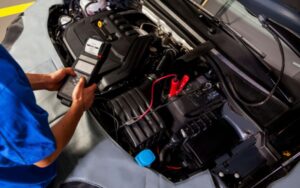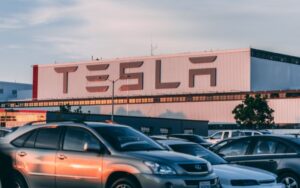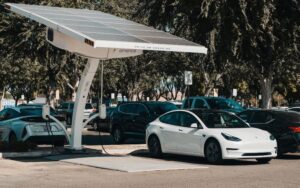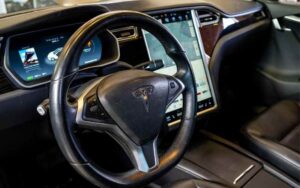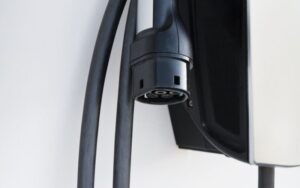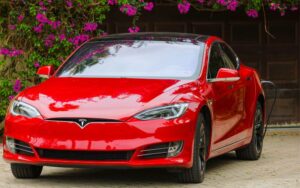Can Tesla Drive Through Water? (Read This First)
Last updated on April 18th, 2023 at 11:17 pm
Models X, Y, S, and all other tesla models are electric cars. However, it is a fact that water and electricity do not go well together.
Thus, as a tesla owner, what if you find yourself in a situation where you’ll need to drive through a certain water level or even in heavy rain? Should you be bothered about electrocution?
You can drive your Tesla through water without worrying about electrocution. Water is not a problem for Teslas because they are airtight, preventing water from getting through to essential parts. Nevertheless, avoiding driving your tesla through water frequently is best to prevent other hazards.
In this article, you’ll learn how well your Tesla can operate on a flooded road, in deep water, in heavy rain and when submerged.
Can You Drive Tesla on a Flooded Road?
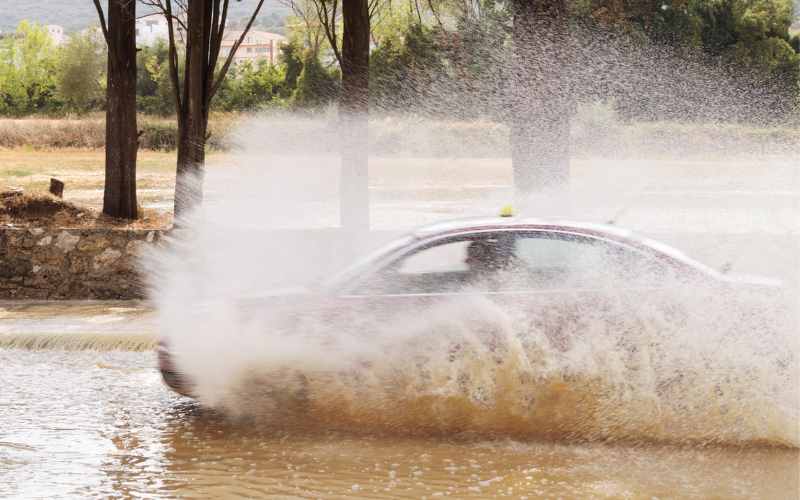
Yes, Tesla can drive through flooded roads; however, you shouldn’t drive your Tesla through flooded roads because it can be pretty dangerous,
Tesla vehicles are electric; they do not need petrol and air when crossing through flooded areas.
In addition, they have a waterproofing system that prevents water from getting into vital parts and causing electrocution.
However, driving on a flooded road for an extended period can cause the waterproofing system of the vehicle to fail and cause damage to certain parts of the vehicle.
When water finds a way of getting through to your Tesla, it may create a fire hazard and an increased risk of electrocution.
Can Tesla Go Through Deep Water?
Yes, Tesla cars can go through deep waters. However, it would be best to be careful around a depth of four inches and above, especially when the car is already faulty.
Most Tesla vehicles can go through deep waters because they are waterproof. Still, exposing Teslas to 4-6 inches of depth of water for a while can compromise the waterproofing system.
In most cases, the Tesla vehicle would seem fine when you drive it out of the water.
However, if you properly inspect the vehicle, you’d notice that some of its parts have become damaged.
When the water gets into the vehicle, the modules in the car will experience corrosion and might explode when you attempt to take them out.
Further, the water will cause mold formation on the soft parts of the car, like the seats and carpets.
In addition, the battery pack’s lithium or nickel metal hydride can be dangerous when exposed to water.
Thus far, only one Teska model can drive through up to six inches of water without any issues. This model is called the Cybertruck.
Here is a table showing the features of a tesla cyber truck that improves its water tolerance:
| Specification | Details |
|---|---|
| Exoskeleton | Made of ultra-hard 30X cold rolled stainless steel skin and Tesla armor glass. |
| Performance | Allows for acceleration from 0-60 mph in 2.9 seconds and a 500 miles range |
| Strength | The cybertruck can tow up to 14,000 pounds |
#1. Exoskeleton
The cybertruck’s design is nearly impenetrable and of maximum durability.
The exoskeleton of the vehicle consists of ultra-hard 30X cold rolled stain steel and tesla armor glass.
Here are the advantages of ultrahard 30X cold-rolled stainless steel:
- Provides the people in the vehicle with maximum protection
- The material prevents dents, damages, and corrosion of the vehicle.
Here are the advantages of the tesla armor glass:
- The tesla armor glass helps to improve damage tolerance in the vehicle
- The tesla armor glass absorbs and redirects force impacted on the vehicle. This feature helps to improve the performance of the vehicle.
#2. Utility
- The cybertruck’s utility is very versatile.
- The vehicle has a lockable exterior storage space of 100 cubic feet.
- The cybertruck is capable of adapting to your needs
- The cybertruck has a towing capability of up to 14000 pounds
#3. Performance
The cybertruck’s low center of gravity and powerful drivetrain facilitate excellent traction and torque control.
The cybertruck allows acceleration from zero to sixty mph in 2.9 seconds and up to 500 miles of range.
Are Teslas Waterproof, and How Much?
Yes, all tesla cars are waterproof. All tesla models are electric; thus, they are designed to be airtight.
Most teslas can allow for exposure to water of up to four inches. However, driving a Tesla through more than four inches of water can cause the vehicle to develop faults.
The doors, windows, engines, battery pack, and every other part of an average tesla car are airtight. Therefore, it prevents water from getting in.
It might worry you for your tesla car to have anything to do with water since it is an electric car. However, getting electrocuted by your Tesla car should be the least of your worries.
Tesla has several safety measures to prevent such electrical hazards, including:
- The circuit breaker will go off when the Tesla detects water in the electrical system, and the battery pack will get isolated to prevent short circuits or collisions.
- High-voltage cables come in bright orange, showing that you should avoid contact with it.
- Tesla’s battery pack has a sealed metal shell preventing current from flowing.
- The nickel-metal hydride batteries are maintenance-free and prevent anything, including water, from passing through them.
- Chemicals in the nickel metal hydride battery are gel-like and will not spill under any circumstance.
- The high-voltage lines in Tesla vehicles are insulated.
Although Tesla cars resist water, you should not leave them in water for too long. The waterproof barrier will break if you leave your tesla car in water for too long.
Here are the disadvantages of leaving your tesla car in water for too long:
- Some of the modules and other metal parts in the vehicle will suffer damage like corrosion. In some cases, this corrosion might further lead to an explosion of the module.
- The water will fill up the battery pack and damage it.
- Water seeping into the vehicle can cause molds to form on soft parts like the seats, carpets, etc. Exposure to molds can sometimes lead to respiratory problems.
- Leaving your tesla in water for too long can cause the battery pack to carry a high and lethal voltage. In addition, it will cost you a lot to seek professional assistance for the damage.
- Your tesla car may create a fire hazard if you leave it in water for an extended period.
- Battery cells in tesla cars contain lithium which is flammable and generates a large amount of heat when exposed to water for a long time.
- You’d have to pay for the repair for damages resulting from water exposure because the warranty won’t cover the repairs.
- The nickel-metal hydride in battery cells causes the formation of hydrogen when in contact with water. Increased hydrogen presence can lead to disorientation and explosion.
What Happens if a Tesla Submerged in Water?
When you submerge a Tesla in water, the vehicle acts like a lifeboat and floats. Recent tesla models have a boat mode feature that activates when the car is in water.
However, submerging your Tesla in water is not recommended. The boat mode feature might fail under certain conditions.
If you leave the vehicle in water for too long, the waterproofing system starts to fail, and the water will flow into the vehicle.
In some cases, when you submerge your Tesla in a certain level of water, the windows will automatically open up, allowing water to flow through freely.
Can Tesla Drive in Rain?
Yes, Tesla cars can drive in the rain. Tesla cars have unique features that help them drive smoothly and safely even in heavy rain.
Here are some of the main features that allow tesla cars to drive safely in the rain:
#1. Large Tires
The type of tires used in a Tesla car is one of the main features that allows the car to drive safely in the rain.
Tesla vehicles’ tires are usually large to accommodate the car’s weight. The manufacturers use high-quality materials and synthetic rubber to make the tires.
The tires usually have thick sidewalls to prevent damage due to the high power during acceleration of the vehicle.
The tires used in Tesla cars have deep treads that push water away and ensure that the tire is always in contact with the road when driving in heavy rain.
#2. Drivetrain
All Tesla cars have either a 4WD or AWD drivetrain. Unlike 2WD vehicles that do not work well in slippery conditions, 4WD and AWD drivetrains are ideal because all wheels receive power.
4WD drivetrains do not work well in normal conditions, while AWD driving systems can adapt and work well under any condition, including rough and rainy conditions.
The Tesla models Y and S have AWD drive trains.
#3. Torque Vectoring
Torque vectoring is a feature in electric cars like Tesla vehicles that prevents the wheels from losing grip during slippery conditions.
When you’re driving your Tesla of 4WD or AWD in the rain, the torque vectoring feature reduces the power in the wheels when they lose grip.
#4. Waterproofing System
You don’t have to worry about getting electrocuted by your Tesla car when driving in the rain because it is waterproof.
Tesla cars are all electric; therefore, they do not allow air intake. In addition, all parts of the tesla vehicle are airtight, preventing water from getting through.

Hey, I’m Michael Davis, a 35-year-old with a degree and a love for cars and tech. Since I was a kid, cars have been my thing—so much that I even thought they ran on magic beans! Fast forward, and I’ve built Vehicle Army, your one-stop-shop for easy-to-understand car facts.

